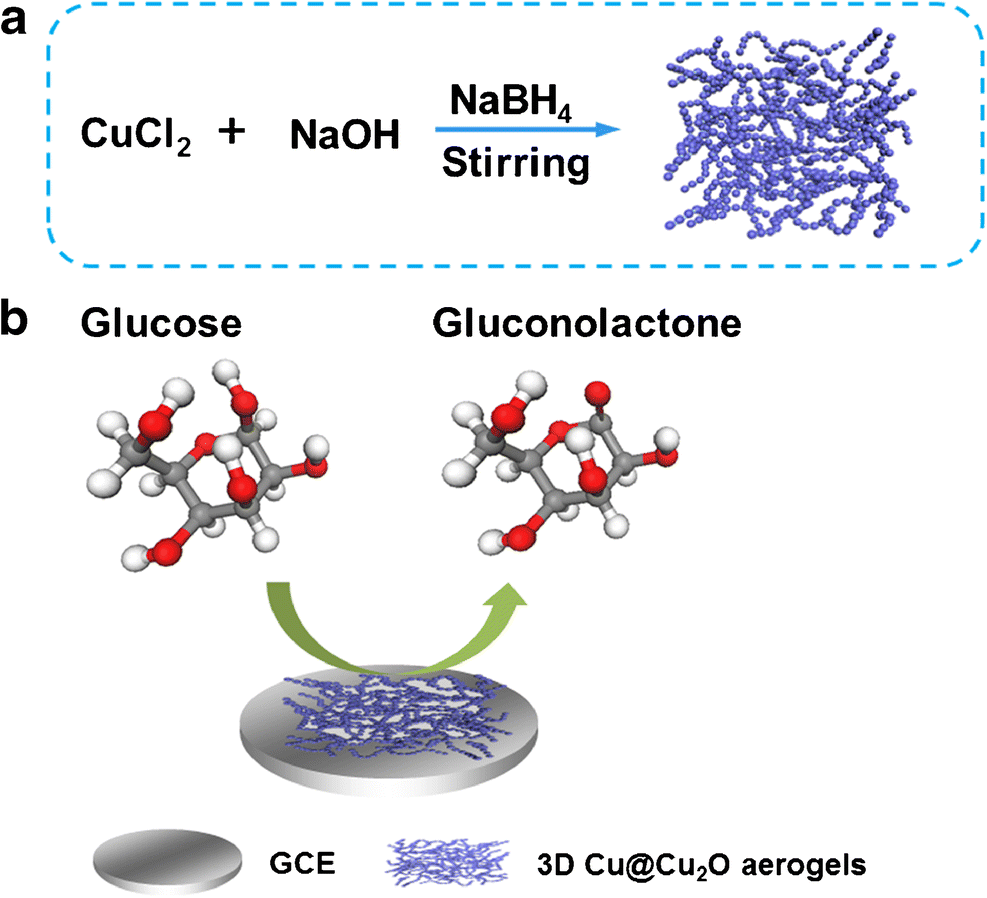当前位置:
X-MOL 学术
›
Microchim. Acta
›
论文详情
Our official English website, www.x-mol.net, welcomes your
feedback! (Note: you will need to create a separate account there.)
Three-dimensional porous Cu@Cu2O aerogels for direct voltammetric sensing of glucose
Microchimica Acta ( IF 5.3 ) Pub Date : 2019-02-18 , DOI: 10.1007/s00604-019-3263-6
Yajun Gao , Feiyu Yang , Qianhui Yu , Rui Fan , Ming Yang , Shengqi Rao , Qingchun Lan , Zhanjun Yang , Zhenquan Yang
Microchimica Acta ( IF 5.3 ) Pub Date : 2019-02-18 , DOI: 10.1007/s00604-019-3263-6
Yajun Gao , Feiyu Yang , Qianhui Yu , Rui Fan , Ming Yang , Shengqi Rao , Qingchun Lan , Zhanjun Yang , Zhenquan Yang

|
AbstractThree-dimensional Cu@Cu2O aerogels with excellent electrocatalytic activity were prepared and used as electrode matrix for constructing novel electrochemical glucose sensors. The aerogels were obtained by adding a fresh solution of NaBH4 into a mixture of CuCl2 and NaOH aqueous solutions under stirring at room temperature. The aerogels were assembled with Cu or Cu2O nanoparticles. The materials show superfine spongy-like structures with large surface-to-volume ratio, numerous active sites and good solubility. The Cu@Cu2O aerogels show highly efficient electrochemical activity toward glucose oxidation with a relatively low-onset potential (0.25 V) in 0.1 M NaOH solution. This non-enzymatic glucose sensor offers a low detection limit of 0.6 μM (S/N = 3), a high sensitivity (195 mA M−1 cm−2), and two wide linear ranges (0.001–5.2 mM, 5.2–17.1 mM) at a working voltage of 0.6 V (vs. Ag/AgCl) in alkaline solution. While in neutral pH values, the respective data are a linear analytical range from 0.1 to 10 mM; a detection limit of 54 μM (S/N = 3) and a sensitivity of 12 mA M−1 cm−2 at scan rate of 100 mV s−1. The sensor possesses high selectivity, good reproducibility and long-time stability. It was utilized to determine glucose levels in (spiked) human serum samples, and satisfactory results were obtained. Graphical abstractSchematic presentation of a glassy carbon electrode modified with 3D porous Cu@Cu2O aerogels. The aerogels were obtained by a reduction reaction at room temperature (Scheme 1A). The aerogel networks were used to develop a highly sensitive electrochemical sensing platform for the detection of glucose (Scheme 1B).
中文翻译:

用于葡萄糖直接伏安法传感的三维多孔 Cu@Cu2O 气凝胶
摘要 制备了具有优异电催化活性的三维 Cu@Cu2O 气凝胶,并将其用作构建新型电化学葡萄糖传感器的电极基质。气凝胶是通过在室温下搅拌下将新鲜的 NaBH4 溶液加入到 CuCl2 和 NaOH 水溶液的混合物中来获得的。气凝胶由 Cu 或 Cu2O 纳米颗粒组装而成。该材料表现出超细海绵状结构,具有大的表面积与体积比,众多的活性位点和良好的溶解性。Cu@Cu2O 气凝胶在 0.1 M NaOH 溶液中以相对低的起始电位 (0.25 V) 显示出对葡萄糖氧化的高效电化学活性。这种非酶葡萄糖传感器提供 0.6 μM (S/N = 3) 的低检测限、高灵敏度 (195 mA M−1 cm−2) 和两个宽线性范围(0.001–5.2 mM、5.2–17 . 1 mM),工作电压为 0.6 V(相对于 Ag/AgCl),在碱性溶液中。而在中性 pH 值下,相应的数据是从 0.1 到 10 mM 的线性分析范围;检测限为 54 μM (S/N = 3),灵敏度为 12 mA M-1 cm-2,扫描速率为 100 mV s-1。该传感器具有高选择性、良好的重现性和长期稳定性。它被用来测定(加标的)人血清样品中的葡萄糖水平,并获得了令人满意的结果。用 3D 多孔 Cu@Cu2O 气凝胶修饰的玻璃碳电极的图形摘要示意图。气凝胶是通过室温下的还原反应获得的(方案 1A)。气凝胶网络用于开发用于检测葡萄糖的高灵敏度电化学传感平台(方案 1B)。Ag/AgCl)在碱性溶液中。而在中性 pH 值下,相应的数据是从 0.1 到 10 mM 的线性分析范围;检测限为 54 μM (S/N = 3),灵敏度为 12 mA M-1 cm-2,扫描速率为 100 mV s-1。该传感器具有高选择性、良好的重现性和长期稳定性。它被用来测定(加标的)人血清样品中的葡萄糖水平,并获得了令人满意的结果。用 3D 多孔 Cu@Cu2O 气凝胶修饰的玻璃碳电极的图形摘要示意图。气凝胶是通过室温下的还原反应获得的(方案 1A)。气凝胶网络用于开发用于检测葡萄糖的高灵敏度电化学传感平台(方案 1B)。Ag/AgCl)在碱性溶液中。而在中性 pH 值下,相应的数据是从 0.1 到 10 mM 的线性分析范围;检测限为 54 μM (S/N = 3),灵敏度为 12 mA M-1 cm-2,扫描速率为 100 mV s-1。该传感器具有高选择性、良好的重现性和长期稳定性。它被用来测定(加标的)人血清样品中的葡萄糖水平,并获得了令人满意的结果。用 3D 多孔 Cu@Cu2O 气凝胶修饰的玻璃碳电极的图形摘要示意图。气凝胶是通过室温下的还原反应获得的(方案 1A)。气凝胶网络用于开发用于检测葡萄糖的高灵敏度电化学传感平台(方案 1B)。各自的数据是从 0.1 到 10 mM 的线性分析范围;检测限为 54 μM (S/N = 3),灵敏度为 12 mA M-1 cm-2,扫描速率为 100 mV s-1。该传感器具有高选择性、良好的重现性和长期稳定性。它被用来测定(加标的)人血清样品中的葡萄糖水平,并获得了令人满意的结果。用 3D 多孔 Cu@Cu2O 气凝胶修饰的玻璃碳电极的图形摘要示意图。气凝胶是通过室温下的还原反应获得的(方案 1A)。气凝胶网络用于开发用于检测葡萄糖的高灵敏度电化学传感平台(方案 1B)。各自的数据是从 0.1 到 10 mM 的线性分析范围;检测限为 54 μM (S/N = 3),灵敏度为 12 mA M-1 cm-2,扫描速率为 100 mV s-1。该传感器具有高选择性、良好的重现性和长期稳定性。它被用来测定(加标的)人血清样品中的葡萄糖水平,并获得了令人满意的结果。用 3D 多孔 Cu@Cu2O 气凝胶修饰的玻璃碳电极的图形摘要示意图。气凝胶是通过室温下的还原反应获得的(方案 1A)。气凝胶网络用于开发用于检测葡萄糖的高灵敏度电化学传感平台(方案 1B)。良好的重现性和长期稳定性。它被用来测定(加标的)人血清样品中的葡萄糖水平,并获得了令人满意的结果。用 3D 多孔 Cu@Cu2O 气凝胶修饰的玻璃碳电极的图形摘要示意图。气凝胶是通过室温下的还原反应获得的(方案 1A)。气凝胶网络用于开发用于检测葡萄糖的高灵敏度电化学传感平台(方案 1B)。良好的重现性和长期稳定性。它被用来确定(加标)人血清样品中的葡萄糖水平,并获得了令人满意的结果。用 3D 多孔 Cu@Cu2O 气凝胶修饰的玻璃碳电极的图形摘要示意图。气凝胶是通过室温下的还原反应获得的(方案 1A)。气凝胶网络用于开发用于检测葡萄糖的高灵敏度电化学传感平台(方案 1B)。
更新日期:2019-02-18
中文翻译:

用于葡萄糖直接伏安法传感的三维多孔 Cu@Cu2O 气凝胶
摘要 制备了具有优异电催化活性的三维 Cu@Cu2O 气凝胶,并将其用作构建新型电化学葡萄糖传感器的电极基质。气凝胶是通过在室温下搅拌下将新鲜的 NaBH4 溶液加入到 CuCl2 和 NaOH 水溶液的混合物中来获得的。气凝胶由 Cu 或 Cu2O 纳米颗粒组装而成。该材料表现出超细海绵状结构,具有大的表面积与体积比,众多的活性位点和良好的溶解性。Cu@Cu2O 气凝胶在 0.1 M NaOH 溶液中以相对低的起始电位 (0.25 V) 显示出对葡萄糖氧化的高效电化学活性。这种非酶葡萄糖传感器提供 0.6 μM (S/N = 3) 的低检测限、高灵敏度 (195 mA M−1 cm−2) 和两个宽线性范围(0.001–5.2 mM、5.2–17 . 1 mM),工作电压为 0.6 V(相对于 Ag/AgCl),在碱性溶液中。而在中性 pH 值下,相应的数据是从 0.1 到 10 mM 的线性分析范围;检测限为 54 μM (S/N = 3),灵敏度为 12 mA M-1 cm-2,扫描速率为 100 mV s-1。该传感器具有高选择性、良好的重现性和长期稳定性。它被用来测定(加标的)人血清样品中的葡萄糖水平,并获得了令人满意的结果。用 3D 多孔 Cu@Cu2O 气凝胶修饰的玻璃碳电极的图形摘要示意图。气凝胶是通过室温下的还原反应获得的(方案 1A)。气凝胶网络用于开发用于检测葡萄糖的高灵敏度电化学传感平台(方案 1B)。Ag/AgCl)在碱性溶液中。而在中性 pH 值下,相应的数据是从 0.1 到 10 mM 的线性分析范围;检测限为 54 μM (S/N = 3),灵敏度为 12 mA M-1 cm-2,扫描速率为 100 mV s-1。该传感器具有高选择性、良好的重现性和长期稳定性。它被用来测定(加标的)人血清样品中的葡萄糖水平,并获得了令人满意的结果。用 3D 多孔 Cu@Cu2O 气凝胶修饰的玻璃碳电极的图形摘要示意图。气凝胶是通过室温下的还原反应获得的(方案 1A)。气凝胶网络用于开发用于检测葡萄糖的高灵敏度电化学传感平台(方案 1B)。Ag/AgCl)在碱性溶液中。而在中性 pH 值下,相应的数据是从 0.1 到 10 mM 的线性分析范围;检测限为 54 μM (S/N = 3),灵敏度为 12 mA M-1 cm-2,扫描速率为 100 mV s-1。该传感器具有高选择性、良好的重现性和长期稳定性。它被用来测定(加标的)人血清样品中的葡萄糖水平,并获得了令人满意的结果。用 3D 多孔 Cu@Cu2O 气凝胶修饰的玻璃碳电极的图形摘要示意图。气凝胶是通过室温下的还原反应获得的(方案 1A)。气凝胶网络用于开发用于检测葡萄糖的高灵敏度电化学传感平台(方案 1B)。各自的数据是从 0.1 到 10 mM 的线性分析范围;检测限为 54 μM (S/N = 3),灵敏度为 12 mA M-1 cm-2,扫描速率为 100 mV s-1。该传感器具有高选择性、良好的重现性和长期稳定性。它被用来测定(加标的)人血清样品中的葡萄糖水平,并获得了令人满意的结果。用 3D 多孔 Cu@Cu2O 气凝胶修饰的玻璃碳电极的图形摘要示意图。气凝胶是通过室温下的还原反应获得的(方案 1A)。气凝胶网络用于开发用于检测葡萄糖的高灵敏度电化学传感平台(方案 1B)。各自的数据是从 0.1 到 10 mM 的线性分析范围;检测限为 54 μM (S/N = 3),灵敏度为 12 mA M-1 cm-2,扫描速率为 100 mV s-1。该传感器具有高选择性、良好的重现性和长期稳定性。它被用来测定(加标的)人血清样品中的葡萄糖水平,并获得了令人满意的结果。用 3D 多孔 Cu@Cu2O 气凝胶修饰的玻璃碳电极的图形摘要示意图。气凝胶是通过室温下的还原反应获得的(方案 1A)。气凝胶网络用于开发用于检测葡萄糖的高灵敏度电化学传感平台(方案 1B)。良好的重现性和长期稳定性。它被用来测定(加标的)人血清样品中的葡萄糖水平,并获得了令人满意的结果。用 3D 多孔 Cu@Cu2O 气凝胶修饰的玻璃碳电极的图形摘要示意图。气凝胶是通过室温下的还原反应获得的(方案 1A)。气凝胶网络用于开发用于检测葡萄糖的高灵敏度电化学传感平台(方案 1B)。良好的重现性和长期稳定性。它被用来确定(加标)人血清样品中的葡萄糖水平,并获得了令人满意的结果。用 3D 多孔 Cu@Cu2O 气凝胶修饰的玻璃碳电极的图形摘要示意图。气凝胶是通过室温下的还原反应获得的(方案 1A)。气凝胶网络用于开发用于检测葡萄糖的高灵敏度电化学传感平台(方案 1B)。

































 京公网安备 11010802027423号
京公网安备 11010802027423号